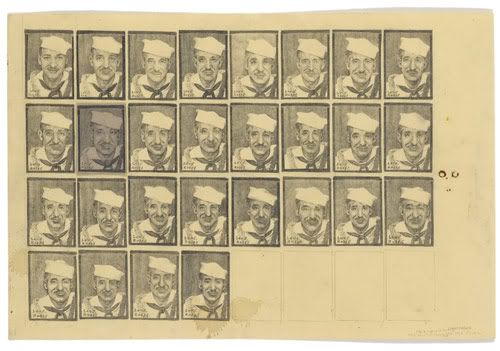
Memory is that capacity within us that we desperately call forth in those last ten minutes of the exam, uncomfortably scanning and re-scanning that last question for which a haphazardly drawn together response was constructed from the faintest of impressions. Our bodies are paralyzed with concentration, yet our minds try at every door, turning knobs and hastily pulling open drawers and cabinets that lie within. Oftentimes, this is the case with voluntary memory — the facts, the abstract words or concepts that have no direct tie to a visual cue require deliberate attention to be committed in our repertoire of knowledge. They ask for much more of our internal resources as they do not automatically strike us in a way that makes them bold against the sea of other lingering thoughts.
Colter Jacobson explores, contrarily, on involuntary memory. He drew the above image, Love Rosie (2008) from a found photograph of a sailor and for a month following, would return to that image in his mind’s eye and regenerate it on paper. As the days pass, the sailor remains distinguishable as a sailor with the same general features — moustache, a sailor’s necktie, friendly eyes — yet his proportions waver relative to one another. The amount of variation is enough to make several of his drawings appear to be different men altogether, yet they all seem to retain the essence that had been most salient in Jacobson’s initial encounter with this man. Details and the diligent specifics might be lacking, but he repeatedly captures that playful, confident smile, the flirtatious edge beheld in his expression. His art piece is not necessarily the sailor himself, but his memory of the sailor and the aesthetic of its volatility, of its subtle inaccuracies. Change is inherent with our vision of time and as events occur – the shattering of a grandmother’s teapot, the acquisition a new job, the acquaintance of a new face — unawares to our conscious selves, our previous memories or at least our perspective from which we look to these previous memories move – liquefied, their edges shift ever so slightly. And of course, this is all coupled with disassembling of the memory itself. Though, like a deteriorating orbit, it never quite loses all trace but retains some essential center that involuntarily stays. This is especially true of visual memory which seems to be more Proustian than for, say, semantic memory.
Being a neuroscience major, it has come to my attention how little we do know about memory, let alone about the brain itself. Despite the acceleration of the sciences, there remains still a great degree of mystery left that cannot possibly be all “resolved†in our lifetime. But if it, by some miracle of human prowess, does, I wonder about the nature of the implications it clearly will have on philosophy and of course, on art.
Sue majors in Neuroscience & English and tends to lurk in bookstores.


Leave a Reply
Be the First to Comment!